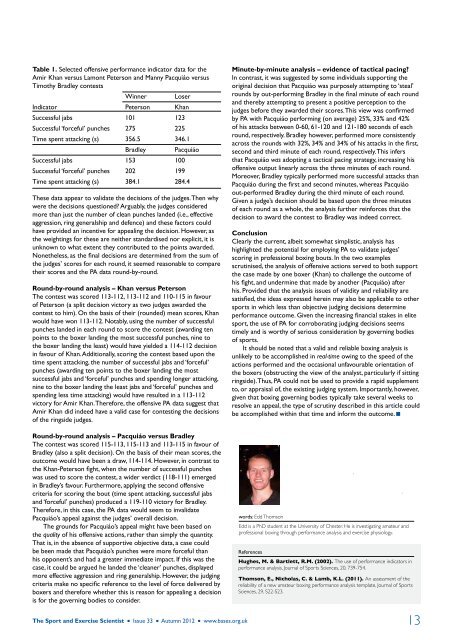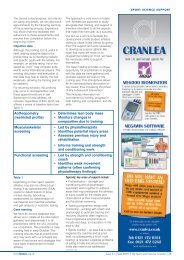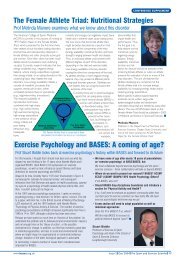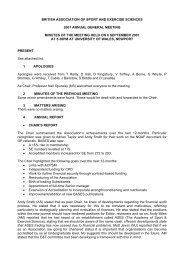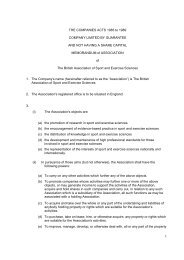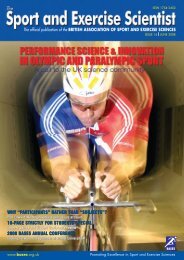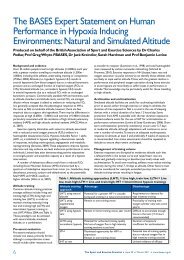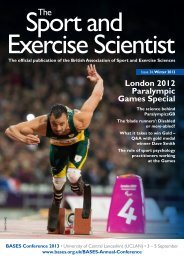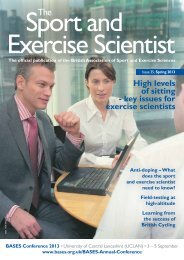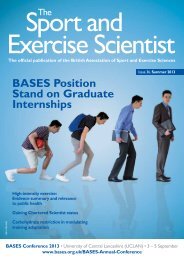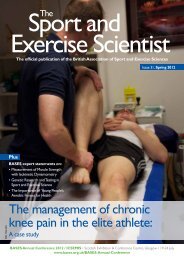Issue 33 Autumn 2012 - Bases
Issue 33 Autumn 2012 - Bases
Issue 33 Autumn 2012 - Bases
- No tags were found...
You also want an ePaper? Increase the reach of your titles
YUMPU automatically turns print PDFs into web optimized ePapers that Google loves.
Table 1. Selected offensive performance indicator data for theAmir Khan versus Lamont Peterson and Manny Pacquiáo versusTimothy Bradley contestsWinner LoserIndicator Peterson KhanSuccessful jabs 101 123Successful ‘forceful’ punches 275 225Time spent attacking (s) 356.5 346.1Bradley PacquiáoSuccessful jabs 153 100Successful ‘forceful’ punches 202 199Time spent attacking (s) 384.1 284.4These data appear to validate the decisions of the judges. Then whywere the decisions questioned? Arguably, the judges consideredmore than just the number of clean punches landed (i.e., effectiveaggression, ring generalship and defence) and these factors couldhave provided an incentive for appealing the decision. However, asthe weightings for these are neither standardised nor explicit, it isunknown to what extent they contributed to the points awarded.Nonetheless, as the final decisions are determined from the sum ofthe judges’ scores for each round, it seemed reasonable to comparetheir scores and the PA data round-by-round.Round-by-round analysis – Khan versus PetersonThe contest was scored 113-112, 113-112 and 110-115 in favourof Peterson (a split decision victory as two judges awarded thecontest to him). On the basis of their (rounded) mean scores, Khanwould have won 113-112. Notably, using the number of successfulpunches landed in each round to score the contest (awarding tenpoints to the boxer landing the most successful punches, nine tothe boxer landing the least) would have yielded a 114-112 decisionin favour of Khan. Additionally, scoring the contest based upon thetime spent attacking, the number of successful jabs and ‘forceful’punches (awarding ten points to the boxer landing the mostsuccessful jabs and ‘forceful’ punches and spending longer attacking,nine to the boxer landing the least jabs and ‘forceful’ punches andspending less time attacking) would have resulted in a 113-112victory for Amir Khan. Therefore, the offensive PA data suggest thatAmir Khan did indeed have a valid case for contesting the decisionsof the ringside judges.Round-by-round analysis – Pacquiáo versus BradleyThe contest was scored 115-113, 115-113 and 113-115 in favour ofBradley (also a split decision). On the basis of their mean scores, theoutcome would have been a draw, 114-114. However, in contrast tothe Khan-Peterson fight, when the number of successful puncheswas used to score the contest, a wider verdict (118-111) emergedin Bradley’s favour. Furthermore, applying the second offensivecriteria for scoring the bout (time spent attacking, successful jabsand ‘forceful’ punches) produced a 119-110 victory for Bradley.Therefore, in this case, the PA data would seem to invalidatePacquiáo’s appeal against the judges’ overall decision.The grounds for Pacquiáo’s appeal might have been based onthe quality of his offensive actions, rather than simply the quantity.That is, in the absence of supportive objective data, a case couldbe been made that Pacquiáo’s punches were more forceful thanhis opponent’s and had a greater immediate impact. If this was thecase, it could be argued he landed the ‘cleaner’ punches, displayedmore effective aggression and ring generalship. However, the judgingcriteria make no specific reference to the level of force delivered byboxers and therefore whether this is reason for appealing a decisionis for the governing bodies to consider.Minute-by-minute analysis – evidence of tactical pacing?In contrast, it was suggested by some individuals supporting theoriginal decision that Pacquiáo was purposely attempting to ‘steal’rounds by out-performing Bradley in the final minute of each roundand thereby attempting to present a positive perception to thejudges before they awarded their scores. This view was confirmedby PA with Pacquiáo performing (on average) 25%, <strong>33</strong>% and 42%of his attacks between 0-60, 61-120 and 121-180 seconds of eachround, respectively. Bradley however, performed more consistentlyacross the rounds with 32%, 34% and 34% of his attacks in the first,second and third minute of each round, respectively. This infersthat Pacquiáo was adopting a tactical pacing strategy, increasing hisoffensive output linearly across the three minutes of each round.Moreover, Bradley typically performed more successful attacks thanPacquiáo during the first and second minutes, whereas Pacquiáoout-performed Bradley during the third minute of each round.Given a judge’s decision should be based upon the three minutesof each round as a whole, the analysis further reinforces that thedecision to award the contest to Bradley was indeed correct.ConclusionClearly the current, albeit somewhat simplistic, analysis hashighlighted the potential for employing PA to validate judges’scoring in professional boxing bouts. In the two examplesscrutinised, the analysis of offensive actions served to both supportthe case made by one boxer (Khan) to challenge the outcome ofhis fight, and undermine that made by another (Pacquiáo) afterhis. Provided that the analysis issues of validity and reliability aresatisfied, the ideas expressed herein may also be applicable to othersports in which less than objective judging decisions determineperformance outcome. Given the increasing financial stakes in elitesport, the use of PA for corroborating judging decisions seemstimely and is worthy of serious consideration by governing bodiesof sports.It should be noted that a valid and reliable boxing analysis isunlikely to be accomplished in real-time owing to the speed of theactions performed and the occasional unfavourable orientation ofthe boxers (obstructing the view of the analyst, particularly if sittingringside). Thus, PA could not be used to provide a rapid supplementto, or appraisal of, the existing judging system. Importantly, however,given that boxing governing bodies typically take several weeks toresolve an appeal, the type of scrutiny described in this article couldbe accomplished within that time and inform the outcome.words: Edd ThomsonEdd is a PhD student at the University of Chester. He is investigating amateur andprofessional boxing through performance analysis and exercise physiology.ReferencesHughes, M. & Bartlett, R.M. (2002). The use of performance indicators inperformance analysis, Journal of Sports Sciences, 20, 739-754.Thomson, E., Nicholas, C. & Lamb, K.L. (2011). An assessment of thereliability of a new amateur boxing performance analysis template, Journal of SportsSciences, 29, S22-S23.The Sport and Exercise Scientist n <strong>Issue</strong> <strong>33</strong> n <strong>Autumn</strong> <strong>2012</strong> n www.bases.org.uk13


